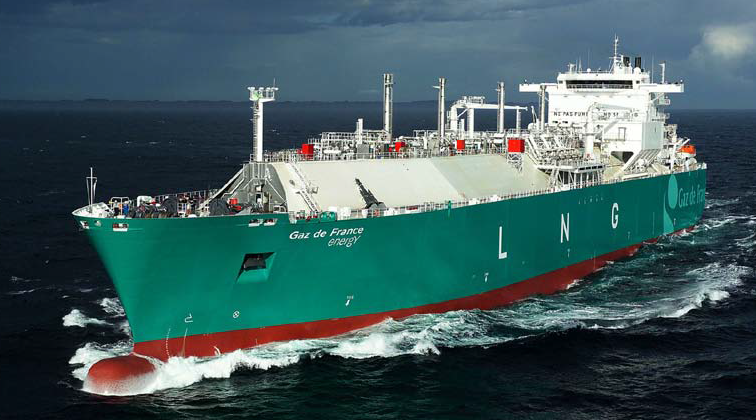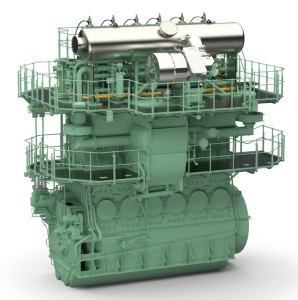Wärtsilä is a world leader in complete lifecycle power solutions for the marine and energy markets. They are major manufacturers of ship engines and power plants for distributed energy. Headquartered in Helsinki, Finland the company has over 18,000 employees and operations in 70 countries. Wärtsilä Marine claims to power one in three ships sailing the world today, they offer ship design, engines, auxiliary systems and all related services.
Wärtsilä marine has embraced LNG fuel and is a pioneer in offering technical solutions for new ships and bunkering. LNG as an alternative marine fuel to traditional bunker fuel (high sulfur fuel oil, HSFO) offers great market potential. LNG is compliant with upcoming Emissions Control Areas (ECA) regulations due its inherent SOx reductions of 99%, but it also emits 85% less NOx than HSFO ensuring compliance with future Tier III NOx regulations whenever they come into effect. LNG offers compliance with the full range of likely future emissions legislation as it also effectively eliminates all harmful particulates and offers a 20% reduction in greenhouse gasses compared to HFSO. The alternative for emissions compliance for ship owners is to use low sulfur distillate fuels and some combination of expensive and elaborate exhaust scrubbers.
The primary driver for ship owners to convert to LNG versus installing exhaust scrubbers is fuel cost. Bunker fuel represents 70% of the operating costs for an international vessel and while distillate fuels command a price premium upwards of 45% above bunker fuel, LNG sells at a discount to bunker fuel in most major markets. The cost advantage of LNG, which is projected to remain steady for the foreseeable future, is compelling ship owners to consider converting.
The challenge for the marine industry is the lack of fueling infrastructure and equipment for LNG. Those keen to use LNG as a fuel are awaiting the arrival of fueling facilities, while those involved in developing bunkering facilities are citing a lack of demand as an impediment to progress. This classic chicken-and-egg scenario is steadily working itself out as LNG ships builds are being announced along with bunkering facilities in select locations. As ECA rules come into effect in 2015 in USA and Europe the premium price for distillate fuels should help compel the industry to quicken the pace of LNG development.
Until the mid-1990’s the use of LNG as marine fuel was limited to bulk LNG container ships which utilized the LNG boil-off as fuel for large steam turbines. This unique example of using cargo as fuel was common throughout the LNG shipping industry, but it was not always efficient as the rate of boil-off did not necessarily sync with fuel demand from the engine leading to waste and shrinkage of cargo. Alternative propulsion systems with gas and diesel engines and LNG regasification equipment came to market to both boost engine efficiencies and minimize cargo loss.
The Provalys, world’s largest LNG carrier when built, runs Wärtsilä dual fuel engines. Photo by Wärtsilä
Wärtsilä is a leader in dual-fuel engine technology and began work in the space in 1987. Early gas engines were gas-diesel engines with high pressure gas injection. In the 1990’s the second generation spark-ignited pure gas engines using low pressure gas were introduced. The real breakthrough came in 1995 with dual-fuel (DF) engines which combine complete fuel flexibility and efficiency with environmental performance. DF engines allow the ship to operate on a combination of heavy fuel oil, distillates and natural gas, switching seamlessly between them all without loss of power. DF engines are the best solution in the current market, allowing shippers to take advantage of which ever fuels are available or required in a given market.
Existing dual fuel engines have mostly been medium speed, of which Wärtsilä’s dual 4-stroke engines have been the market leader since 2005. These high pressure engines are diesel engines modified to use natural gas and enable total fuel flexibility with the ability to switch between heavy fuel oil, distillates and natural gas, offering the best in emissions performance under all types of fuel. Wärtsilä’s 4-stroke engines are proven and suitable for a wide range of applications ranging from large LNG carriers down to small tugs and ferries. A wide power range is offered enabling optimization for every type of application including both mechanical drive and power generation sets.
Wärtsilä aims to extend its experience in dual fuel power to 2-stroke engines. Wärtsilä’s new 2-stroke engines promise to be a “game-changer” for the industry. Released for sale in 2013, the 2-stroke series is designed as a gas engine that that uses diesel as a backup fuel and they far surpass the most stringent IMO Tier III emissions regulations without the use of emissions after treatment systems, which no other 2-stroke engine can achieve. The key to this performance is the use of low-pressure gas injection which allows the gas to burn more cleanly with less NOx formation and less methane slip, in addition SOx and particulate emissions are essentially eliminated. Wärtsilä’s 2-stroke engine is expected to provide CAPEX (capital expenditure) savings of between 15% – 20% compared to other 2-stroke gas engines due to the fact that no exhaust gas cleaning systems are needed and the LNG and gas handling system is substantially simpler and lower cost because only low pressure gas compression is required. The engine also offers stable performance across the entire load range meaning that at low loads there is no need to switch to diesel, helping to reduce OPEX (operating expenditure).
Wartsilia’s new RT-flex 50DF, 2-stroke, dual fuel, low-pressure engine. Graphics by Wartsilia
New ships using low-pressure 2-stroke dual fuel engines are considered the most environmentally friendly in the world. As the maritime industry adapts to emissions regulations and cost pressures dual fuel and LNG engines are expected to become the propulsion of choice. The first market segments are expected to be chemical tankers and LNG carriers as well as vessels such as tugs, ferries, and cruise liners that operate frequently inside ECA zones. Another near term opportunity for LNG is the offshore Floating Production Storage & Offloading (FPSO) ships and Platform Supply Vessels (PSVs) which have a need for flexibility, fuel efficiency, and environmental compliance and are increasingly being outfitted with dual fuel engines.
Wartsilia is also involved in all aspects of LNG fuel handling for ships. Their LNGPac product is a complete fuel gas handling system for LNG fuelled ships including tanks, bunkering station, related process equipment and associated control and monitoring systems. Wärtsilä offers ship-board regasification solutions, as well as LNG Boil-Off Gas (BOG) reliquefaction plants and shore-side LNG liquefaction. Wärtsilä is a major player in land based gas and liquid fuel power plants, utilizing their natural gas technologies in complementary fashion there as well.
Published at FC Gas Intelligence, Nov. 7, 2014

